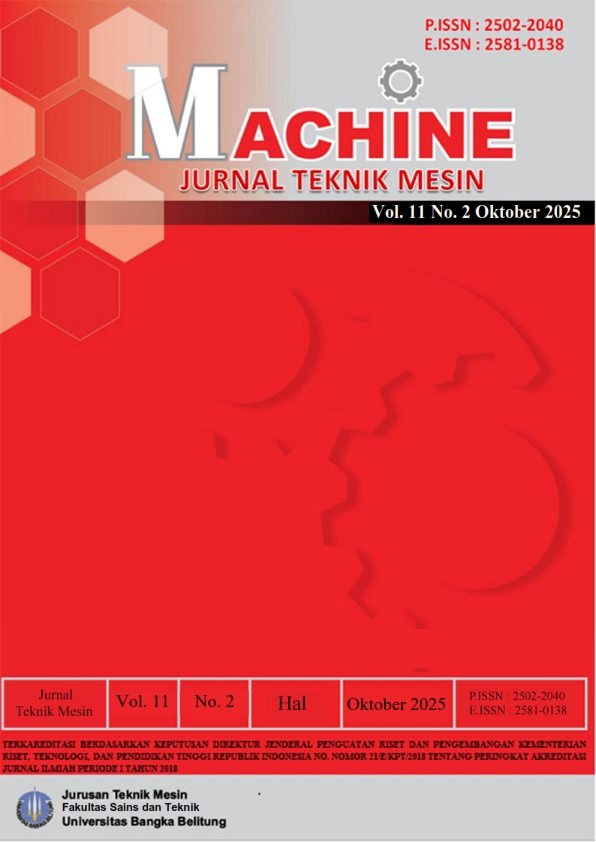Dampak Kebocoran Riser Wall Tube terhadap Produksi Energi dan Kerugian kWh pada Sistem Pembangkit Listrik: Studi Kasus PLTU XYZ Unit 1
DOI:
https://doi.org/10.33019/5py2m660Keywords:
riser wall tube, kebocoran, PLTU, efisiensi energi, kerugian kWhAbstract
Kebocoran pada riser wall tube merupakan salah satu permasalahan utama pada boiler pembangkit listrik tenaga uap (PLTU) karena berperan vital dalam proses pembentukan uap sehingga kegagalannya berdampak langsung pada kinerja termodinamika dan kontinuitas operasi pembangkit. Tujuan penelitian ini adalah untuk menganalisis dampak kebocoran riser wall tube terhadap performa termodinamika dan kerugian energi pada PLTU XYZ Unit 1. Penelitian ini menganalisis kasus kebocoran riser wall tube dengan membandingkan kondisi operasional sebelum dan sesudah kejadian. Data menunjukkan penurunan beban dari 49,3 MW menjadi 40 MW, penurunan tekanan uap utama dari 8,6 MPa menjadi 8,13 MPa, serta penurunan temperatur uap dari 536 °C menjadi 530°C. Selain itu, tekanan furnace meningkat signifikan dari -214 Pa menjadi 2.500 Pa, sedangkan tekanan windbox naik dari 12,3 kPa menjadi 17,5 kPa. Kondisi ini diikuti penurunan efisiensi boiler dari 88% menjadi 80% dan peningkatan konsumsi bahan bakar. Hasil perhitungan menunjukkan total kerugian energi sebesar 5.968.095 kWh dengan nilai kerugian finansial mencapai Rp. 4.243.613.949, menegaskan bahwa kebocoran riser wall tube tidak hanya menurunkan performa teknis pembangkit, tetapi juga menimbulkan kerugian ekonomi yang signifikan. Penelitian ini menyimpulkan bahwa penerapan strategi predictive maintenance, inspeksi rutin dengan metode non-destructive test (NDT), serta monitoring real-time parameter operasi menjadi langkah penting untuk meningkatkan keandalan, memperpanjang umur komponen kritis, dan meminimalkan risiko kerugian akibat kebocoran serupa di masa mendatang.
Downloads
References
[1] G. Prokhorskii, S. Rudra, M. Preissinger, and E. Eder, “A data-driven regression model for predicting thermal plant performance under load fluctuations,” Carbon Neutrality, vol. 3, Oct. 2024, doi: 10.1007/s43979-024-00108-5.
[2] C. Bhattacharya, B. Saha, J. Manna, and S. Bera, Impact of Boiler Tube Failure in Power Pricing & Profitability. 2007.
[3] C. deni Mulyadi, T. Kristyadi, A. Putra, and D. Rusirawan, “Analisa Prestasi Pembangkit Listrik Tenaga Uap (PLTU) Berbahan Bakar BatuBara Hasil Upgrading,” Infotekmesin, vol. 12, pp. 81–87, Mar. 2021, doi: 10.35970/infotekmesin.v12i1.370.
[4] M. Dharmakusuma, B. Belyamin, and W. Widiyatmoko, “Analisis Eksergi Pada Boiler PLTU,” Jurnal Mekanik Terapan, vol. 1, pp. 45–53, Oct. 2020, doi: 10.32722/jmt.v1i1.3331.
[5] D. Ghosh, H. Roy, A. Saha, and C. Subramanian, “Failure Analysis of Boiler Water Wall Tube: A Case Study from Thermal Power Plant,” Journal of Failure Analysis and Prevention, vol. 22, Jan. 2022, doi: 10.1007/s11668-021-01271-y.
[6] L. Pang, S. Yi, L. Duan, W. Li, and Y. Yang, “Thermal Stress and Cyclic Stress Analysis of a Vertical Water-Cooled Wall at a Utility Boiler under Flexible Operation,” Energies (Basel), vol. 12, p. 1170, Mar. 2019, doi: 10.3390/en12061170.
[7] R. K. Hosseini and Sh. Yareiee, “Failure analysis of boiler tube at a petrochemical plant,” Eng Fail Anal, vol. 106, p. 104146, 2019, doi: https://doi.org/10.1016/j.engfailanal.2019.104146.
[8] X. Sun, Y. Ning, J. Yang, Y. Zhao, Z. Yang, and X. Zhou, “Study on high temperature corrosion mechanism of water wall tubes of 350 MW supercritical unit,” Eng Fail Anal, vol. 121, p. 105131, 2021, doi: https://doi.org/10.1016/j.engfailanal.2020.105131.
[9] S. Xue et al., “Analysis of the causes of leakages and preventive strategies of boiler water-wall tubes in a thermal power plant,” Eng Fail Anal, vol. 110, p. 104381, 2020, doi: https://doi.org/10.1016/j.engfailanal.2020.104381.
[10] A. K. Sethi and O. Vikash, “Failure analysis of the water-wall tube in once through Benson boiler,” Mater Today Proc, 2022, doi: https://doi.org/10.1016/j.matpr.2022.12.143.
[11] P. Tadge, S. Kumar, S. Kumar De, and S. Kumar Mohanty, “Metallurgical investigation of boiler tube failure in a power plant,” Mater Today Proc, vol. 66, pp. 3799–3803, 2022, doi: https://doi.org/10.1016/j.matpr.2022.06.164.
[12] Z. Yan, L. Wang, X. Li, J. Wei, C. Liu, and Y. Da, “Failure mechanism of superheater tubes of waste heat boiler for waste incineration in complex environment,” Eng Fail Anal, vol. 139, p. 106457, 2022, doi: https://doi.org/10.1016/j.engfailanal.2022.106457.
[13] M. Nurbanasari et al., “Metallurgical analysis of a water wall tube leakage in a 600-MW coal-fired power plant,” Eng Fail Anal, vol. 182, p. 110004, 2025, doi: https://doi.org/10.1016/j.engfailanal.2025.110004.
[14] J. H. Bulloch, A. G. Callagy, S. Scully, and A. Greene, “A failure analysis and remnant life assessment of boiler evaporator tubes in two 250MW boilers,” Eng Fail Anal, vol. 16, no. 3, pp. 775–793, 2009, doi: https://doi.org/10.1016/j.engfailanal.2008.06.020.
[15] S. Noori and J. Price, “A risk approach to the management of boiler tube thinning,” Nuclear Engineering and Design, vol. 236, pp. 405–414, Feb. 2006, doi: 10.1016/j.nucengdes.2005.09.019.
[16] D. S and J. A. V. V, “Analysis of corrosive degradation and failure of water wall tubes,” Mater Today Proc, vol. 62, pp. 2168–2172, 2022, doi: https://doi.org/10.1016/j.matpr.2022.03.359.
[17] P. S. Sanjay and D. R. K. Mandloi, “A Failure Analysis and Remaining Life assessment of Boiler Water Wall tube,” International Journal of Advanced Engineering Research and Science, vol. 3, no. 7, 2016.
[18] M. Gabonewe, M. Munsamy, and A. Telukdarie, Evaluating the effectiveness of a boiler plant’s predictive maintenance system. 2021. doi: 10.1109/TEMSCON-EUR52034.2021.9488631.
Downloads
Published
Issue
Section
License
Copyright (c) 2025 Machine : Jurnal Teknik Mesin

This work is licensed under a Creative Commons Attribution 4.0 International License.
The paper presented is assumed not to contain proprietary materials that are not protected by patents or patent applications. Responsibility for technical content and for protection from proprietary materials is the responsibility of the author and their organization and not the responsibility of the machine or its editorial staff. The primary author (first / appropriate) is responsible for ensuring that the article has been viewed and approved by all other authors. It is the responsibility of the author to obtain all copyright release permits required for the use of any copyrighted material in the manuscript before submission.











